Indicator scoreboardGermany — April Statistics Office seasonally and workday adjusted retail sales excluding autos and gas stations fell 2.4 percent and 1.9 percent when compared with last year. However, the Bundesbank seasonally adjusted data excluding auto and gas station sales rose 1.8 percent in April but declined 2.2 percent on the year. Data issued by the Bundesbank for real seasonally adjusted retail sales including autos and gas stations rose 1.5 percent but fell 2.2 percent when compared with last year. The explanation for the difference in results is the different seasonal adjustment methods the two agencies use. They can give quite different results, particularly in March and April due to the changing time of Easter. 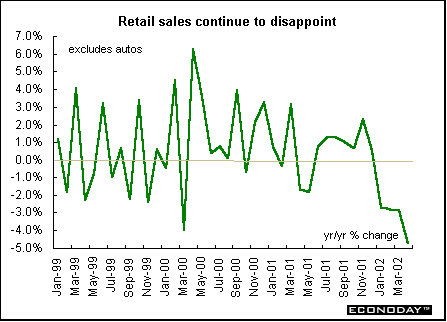 April seasonally adjusted industrial production rose 0.2 percent but fell 2.0 percent when compared with last year. The slight increase was due solely to a 2.3 percent gain in investment goods production and a 2.4 percent rise in energy goods output. All other categories declined on the month. Total manufacturing output rose 0.3 percent, the same as in March. Construction sector output dropped 3.0 percent after sinking 6.2 percent in March. Excluding construction, April industrial production rose 0.4 percent on the month after rising 0.3 percent. Seasonally adjusted west German industrial output rose 0.3 percent after falling 0.2 percent in March, while in the east production fell 1.1 percent in April after a 1.0 percent drop in March.  April non-adjusted merchandise trade surplus declined to €9.3 billion from €11.7 billion in March. On a seasonally and calendar adjusted basis, exports rose 2.1 percent while imports rose 4.8 percent. Compared to a year ago, April unadjusted exports rose 5.7 percent while unadjusted imports fell 0.5 percent. The Statistical Office data must be interpreted cautiously, since they are adjusted for neither seasonal nor inflation effects. France — April seasonally and workday adjusted industrial output rose 0.4 percent and was up 0.9 percent when compared with last year. Manufacturing output was up 0.5 percent and 0.2 percent on the year. Auto output was up 1.2 percent for the second month. Consumer goods rebounded 0.9 percent after a 0.3 percent dip in March. Capital and semi-finished goods output remained soft, with monthly growth up marginally to 0.3 percent and 0.2 percent, respectively. Energy output rose 1.4 percent after rising 2.1 percent in March. April seasonally adjusted merchandise trade surplus rose to €1.894 billion. Exports rose 4.7 percent led by increases in capital goods and auto industry products. Imports rose 1.8 percent led by autos and basic/semi-finished goods. The energy deficit rose to €1.861 billion from €1.832 billion. Italy — First quarter gross domestic product rose 0.2 percent and 0.1 percent when compared with last year. The first quarter's growth was due entirely to a rebound in inventories; domestic demand and net exports declined. GDP data are unique among large eurozone countries in that they are seasonally but not workday adjusted.  April seasonally and workday adjusted industrial production sank 1.0 percent after a 0.7 percent decline in March, largely due to the general strike held on April 16. When compared with last year, industrial production dropped 3.6 percent. April consumer goods output fell 2.1 percent, output of investment goods shed 2.3 percent while intermediate goods edged up 0.2 percent. Britain — May output prices rose 0.3 percent and 0.1 percent when compared with last year. Core output prices, which exclude food, tobacco, petroleum and beverages, rose 0.2 percent and 0.4 percent on the year. Some of the latest rise in output prices was due to the introduction of a new levy April 1 on the extraction of aggregates (sand, gravel and rock). Seasonally adjusted input prices fell 0.7 percent and were 6.2 percent below levels of a year earlier. The main downward influence on input prices was a 1.2 percent drop in crude oil prices. Other downward effects came from fuel, imported food materials and other imported materials.  April manufacturing output rose 0.8 percent but it was down 4.4 percent on the year, while industrial output was up 1.1 percent on the month and down 4.1 percent on the year. Within manufacturing, there was increased output in 10 out of the 13 sub-sectors, with the largest rises in electrical and optical equipment and transport equipment. 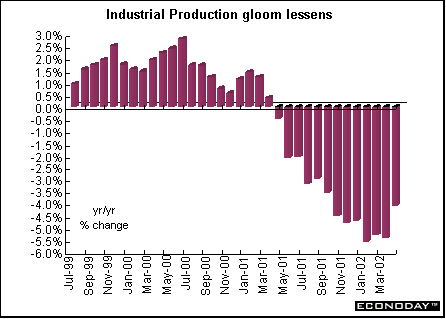 April global merchandise trade deficit fell to Stg2.433 billion from Stg2.765 billion in March. Much of the improvement was due to a significant fall in the deficit with EU countries. The trade gap with non-EU countries widened slightly. Global goods exports rose 2.6 percent while imports rose 0.4 percent. Excluding oil and erratic items, the deficit narrowed from Stg3.279 in March to Stg2.994 in April. May claimant count unemployment rate slipped down to 3.1 percent from 3.2 percent in the prior month. The number claiming benefits fell by 7,000. Since September 2001, the claimant count measure has fallen by 7,200 despite a no-growth economy through both the fourth quarter of last year and the first quarter of this year. Employment on International Labor Organization measure rose 88,000 in the February to April period when compared with the previous 3 months. The employment rate rose to 74.6 percent, up 0.1 percentage points from the previous three-month period.  Average earnings for the three months to April rose 3.3 percent from 2.9 percent when compared with the same months last year. April average earnings rose 4.0 percent from 3.5 percent. Excluding bonuses, earnings growth fell to 4 percent on the year from 4.3 percent in March. The main upward pressure on earnings came from private sector earnings growth, which increased to 3.1 percent from 2.6 percent in March. Unit wage costs rose 3.9 percent in the three months to April compared with the previous year. 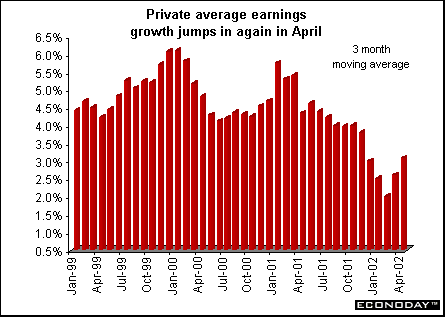 Asia Japan — May domestic wholesale prices fell 1.2 percent when compared with last year, marking the 20th consecutive decline. April seasonally adjusted machinery orders rose 11.3 but fell 12.7 percent when compared with last year. Core orders — a key leading indicator of spending on plant and equipment — were up 8.4 percent but still 17.9 percent below last year. April seasonally adjusted current account surplus, the broadest measure of trade because it includes investment and services, shrank to ¥1.16 trillion ($9.2 billion) from ¥1.55 trillion yen in March. The merchandise trade surplus widened. Exports rose 1.2 percent in April and imports dropped 2.1 percent, underscoring the weakness of domestic demand. The trade surplus widened to ¥1.06 trillion, on a current account basis, from ¥950 billion in March. The income account surplus, which tracks profits, dividends and interest payments, shrank to ¥592.4 billion in April from ¥802 billion in March. April’s current account surplus expanded for the seventh straight month, rising 21.7 percent from a year earlier. May bankruptcies rose 3.9 percent when compared with a year ago, according to credit research firm Tokyo Shoko Research Ltd. This was the ninth straight month that they increased. The bankrupt companies owed ¥1.34 trillion ($10.7 billion). This year, 21 publicly traded companies have already failed, breaking last year's record of 14. Overall 8,299 companies failed in the first five months of 2002 at a rate of 55 a day, just shy of the 1984 pace when a record 20,841 companies failed. Bankruptcies at construction companies, which employ one in ten Japanese, rose 549, their highest level this year and leaving ¥118 billion in liabilities. The number of bankrupt manufacturers rose a ninth straight month from year ago levels to 347, leaving ¥179.2 billion in liabilities. Americas Canada — First quarter capacity utilization rose to 81.7 percent, up from 80.4 percent in the fourth quarter of 2001. It was the first increase since the second quarter of 2000, when the rate reached 86.3 percent. The increase was largely attributable to the manufacturing sector, which recorded its biggest gain in capacity use in more than three years, and more particularly to motor vehicle and automotive parts manufacturers, who benefited from strong demand. Of the 21 major industry groups in this sector, 17 posted an increase in their rate of capacity use. 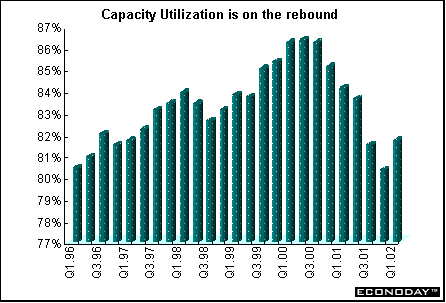 May unadjusted consumer prices rose 0.2 percent and 1.0 percent when compared with last year. Traveler accommodations and cigarettes put the upward pressure on the index while downward pressure largely came from lower prices for fresh vegetables and gasoline. Excluding food and energy, the CPI rose 0.4 percent and 2.4 percent on the year. The seasonally adjusted CPI declined 0.2 percent but rose 0.8 percent when compared with last year. The Bank of Canada has a control target of 1 percent to 3 percent for consumer price inflation. 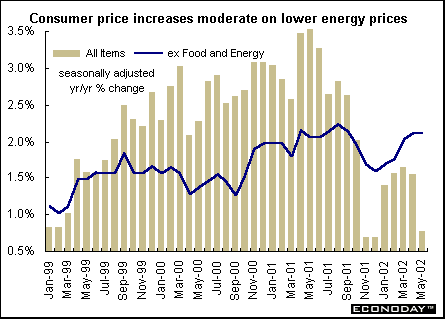 | ![[Back To Archive]](../../../images/backtoarchive.gif)